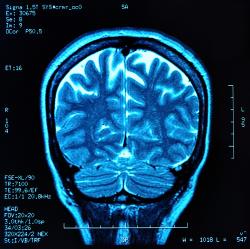 Using a special type of magnetic resonance imaging (MRI), researchers have found that soldiers who suffered mild traumatic brain injury (MTBI) induced by blast exposure present long-term brain differences, according to a new study of veterans.
Using a special type of magnetic resonance imaging (MRI), researchers have found that soldiers who suffered mild traumatic brain injury (MTBI) induced by blast exposure present long-term brain differences, according to a new study of veterans.
 Using a special type of magnetic resonance imaging (MRI), researchers have found that soldiers who suffered mild traumatic brain injury (MTBI) induced by blast exposure present long-term brain differences, according to a new study of veterans.
Using a special type of magnetic resonance imaging (MRI), researchers have found that soldiers who suffered mild traumatic brain injury (MTBI) induced by blast exposure present long-term brain differences, according to a new study of veterans.
The research was presented at the annual meeting of the Radiological Society of North America (RSNA), which brings together tens of thousands of radiologists, technicians, manufacturers — and me — to the mammoth McCormick Place Convention Center hard by the lakefront in Chicago.
Wars in Iraq and Afghanistan have resulted in vets with an exposure rate of 20 percent to blast-induced MTBI, or trauma resulting from mortar fire and improvised explosive devices. Diagnosis of MTBI “is difficult to identify using standard CT or MRI,” said study co-author P. Tyler Roskos, Ph.D., a neuropsychologist and assistant research professor at the St. Louis University School of Medicine in St. Louis, Mo. Other methods appear to be more sensitive.
One of those methods is diffusion tensor imaging (DTI), an MRI technique used to identify microstructural injury to white matter, the part of the brain that consists mostly of signal-carrying axons. Damage associated changes in water movement along the axons can be compared in certain respects to what might happen in a garden hose. “As water passes through the hose from faucet to sprinkler, it goes the same direction, but if you were to puncture the hose with a rake, the water would shoot out the sides,” explained study co-author Thomas M. Malone, a research associate at St. Louis University School of Medicine.
In the study, researchers compared DTI-derived fractional anisotropy (FA) values in 10 Iraq vets who had been diagnoses with MTBI with those of 10 healthy controls. FA measures the uniformity of water diffusion throughout the brain, and low FA tends to indicate areas of axonal injury. The average time elapsed between the blast-induced injury and DTI among the patients was 51.3 months.
Comparison of FA values showed significant differences between the two groups and there were significant correlations between FA values and attention, delayed memory and psychomotor test scores. Since the victims were, on average, more than four years removed from their injuries, the results suggest the presence of a long-term impact of blast injury on the brain.
“DTI shows promised in enhanced sensitivity for detecting MTBI compared to MRI/CT, even in the chronic phase,” Dr Roskos said. “Identification of changes in specific brain regions may help in diagnosis and treatment of MTBI among veterans.”
Dr. Roskos explained that this research is aimed at finding better ways for the clinician to differentiate between MTBI and PTSD in vets in order to improve treatment. And it’s all in the quality of an image!
Click here for more information about Siemens at RSNA:
(MRI brain scan / shutterstock)








